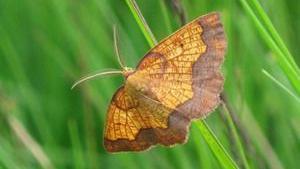MoD balances training with saving rare moth

Strensall Common near York is the only place in England where the dark-bordered beauty moth is found
- Published
The Ministry of Defence (MoD) is trying to save a rare British moth from extinction while also using its site for military training.
The rare dark-bordered beauty moth exists at one last known site in England, the military training area at Strensall Common near York.
The MoD, which owns the Site of Special Scientific Interest (SSSI) said it would be working with the Defence Infrastructure Organisation (DIO) and biologists from the University of York to try to protect the moth.
Retired Major Patrick Ennis, of the DIO and MoD Strensall Conservation Group, said the needs of the military and the moth must be balanced.
"While the primary use of the land is to enable our military to train, we are equally committed to supporting nature recovery by balancing the conservation of species and their habitats with military training requirements," he said.
'Enormous cultural importance'
The moth's numbers have dwindled by more than 90% since records began at Strensall Common in 1894, and only 50 to 100 now remain in the 57-hectares of open heathland.
The moth eats and lays its eggs on creeping willow which grows at the edge of the common's woodland, but the willow is dwindling because of wildfires and grazing by sheep and cattle, and therefore so is the moth.
To help save the moth, the MoD said it was providing funding and materials for the Defence Infrastructure Organisation (DIO) to fence creeping willow which had been advised by University of York biologists.
Volunteers with the charity Butterfly Conservation were also growing more creeping willow from seed.
Dr Peter Mayhew, from the University, said the moth was of "enormous cultural importance".
"[This] was the population where the moth was first discovered in the UK," he said.
"The moth has only survived thanks to the protection of the heathland provided by the military training area.
"Seeing the moth fly on a sunny morning is a never-to-be-forgotten experience which future generations deserve to enjoy."
The local Yorventure charity has also provided funding and conservationists are considering a trial scheme for captive breeding of the moth around York.
The only other place the dark-bordered beauty moth can be found is in Scotland's Cairngorms, where a project saw 160 of the moths released in a bid to increase their population and save them from extinction.
Listen to highlights from North Yorkshire on BBC Sounds, catch up with the latest episode of Look North or tell us a story you think we should be covering here, external.